| General | | Rhodes is known for the Colossus of Rhodes, a huge statue overlooking the harbor of Rhodes town and was one of the seven wonders of the world. The Colossus of Rhodes is known to us through ancient writings (Polybius, Strabo, Pliny, Lucian) and Byzantine chronicles (Philo, Michael the Syrian and Constantine Porphyrogenitus). |
| | History | | The Colossus of Rhodes was built to celebrate the strength of the Rhodians allies Egypt the Greek dynasty of the Ptolemies, armies of Monophtalmos Antigone, King of Macedonia. The son of the king of Macedon Demetrius Poliorcetes besieged the island of Rhodes, but could not overcome the Rhodians who had sent reinforcements Ptolemy (305-304 BC). After some hard battles, the Macedonians failed to take Rhodes, leaving a large part of their military equipment that is sold by the inhabitants of Rhodes. With the money raised, they decided to erect a magnificent bronze statue to thank their patron, the Greek sun god Helios. |
| | Construction | 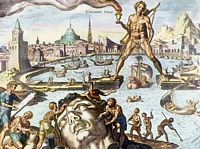 The statue was built between 304 and 292 BC by Chares of Lindos . The statue was built between 304 and 292 BC by Chares of Lindos .The construction of the statue 32 m high lasted only 12 years, which means for the time, remains a technical challenge. The Colossus was entirely made of wood and bronze with a marble base. It was first build a wood core. Once the frame in place, the wooden structure was covered with huge bronze plaques. Cast in place in molds of clay, the statue was gradually rising through a scaffolding blocks of stone ballast to allow different parts of the body at the time of assembly. The foundry of the island is not sufficient to fulfill the requirements of such an undertaking, it was necessary to import large quantities of copper. Expenditure for the construction of the Colossus was 300 talents. | | Chares of Lindos | | The Colossus of Rhodes is the sculptor Chares, a native of Rhodian Lindos , famous disciple of Lysippus, whose best known works are Eros Cordant bow at the Capitoline Museum, the portrait of Alexander the Great at the Glyptotek in Munich Silenus child Dionysus Chiaramonti Museum, the Pugilist at the Spa Palace Massimo alle Terme, Apoxyomenos museum Pio-Clementine Vatican Farnese Hercules and the National Archaeological Museum of Naples. The uncompromising sculptor ended his days when he discovered an error in his calculations, the error was corrected later by one of his assistants. |
|  Description Description | _small.jpg) 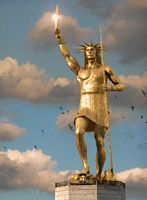 The Colossus of Rhodes represented Helios, the sun god and chief deity of Rhodes , standing, holding a torch in one hand he pointed to the sky, his other arm leaning on a spear and winner of sunlight, according Philo. The Colossus of Rhodes represented Helios, the sun god and chief deity of Rhodes , standing, holding a torch in one hand he pointed to the sky, his other arm leaning on a spear and winner of sunlight, according Philo.From head to toe, the Colossus of Rhodes measured 79 cubits (32 m) tall and weighed 20 tons; few men could kiss his thumb, and the length of his fingers surpassed the height of ordinary statues. High about 14 meters shorter than the Statue of Liberty in New York, the colossal statue of the Colossus of Rhodes was visible to all ships heading to the island of Rhodes. |
| | Location | 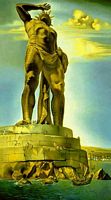 _small.jpg) | 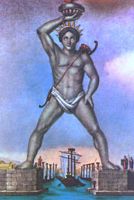 According to tradition, the Colossus stood at the entrance of the Mandraki harbor , signaling its entry into the browser with his torch, and ships passing between his spread legs. According to tradition, the Colossus stood at the entrance of the Mandraki harbor , signaling its entry into the browser with his torch, and ships passing between his spread legs.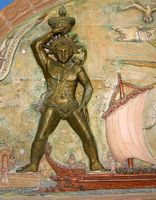 This hypothesis emerged in the Renaissance, a statue with legs spread is unrealistic given the weight of the statue and the burden should support points. The spacing of the legs was not compatible with this situation: after static studies of British specialists, the pillars on which rested had the feet of the statue should have been separated from forty meters of According to the observations of the seabed in the Bay of Rhodes conducted by these researchers. The difference thus found would not reflect the height of the statue, 33 m, the distance between the legs of the colossus can not, according to his height be more than 12 m. This hypothesis emerged in the Renaissance, a statue with legs spread is unrealistic given the weight of the statue and the burden should support points. The spacing of the legs was not compatible with this situation: after static studies of British specialists, the pillars on which rested had the feet of the statue should have been separated from forty meters of According to the observations of the seabed in the Bay of Rhodes conducted by these researchers. The difference thus found would not reflect the height of the statue, 33 m, the distance between the legs of the colossus can not, according to his height be more than 12 m.
Especially in collapsing during the earthquake, the giant was precipitated into the water and could clogged port completely, which is not mentioned anywhere. | Today archaeologists are still looking for the exact location and shape of the Colossus of Rhodes, other avenues are explored: 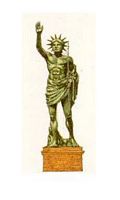 hypothesis, advocated among others by the German archaeologist and architect Wolfram Höpfner, place the Colossus of Rhodes at the entrance to the other port of Rhodes: the military port. According to the Colossus of Rhodes Höpfner included a "Helios" waving his right hand. hypothesis, advocated among others by the German archaeologist and architect Wolfram Höpfner, place the Colossus of Rhodes at the entrance to the other port of Rhodes: the military port. According to the Colossus of Rhodes Höpfner included a "Helios" waving his right hand.- Another hypothesis is that the statue found himself on the heights of the island (or below the Acropolis), and overlooking the bay of Rhodes, giving a particular majesty Helios and giving the statue a superhuman dimension.
- Another assumption of the Colossus should be at the bottom of the port and opposite the entrance to the basin of the galleys, over two towers we see today.
- more likely, the Colossus stood on the site of the Palace of the Grand Masters, the first site of a ancient temple dedicated to Apollo.
|
| | Destruction | | Colossus but not for long dominated the port of Rhodes : in 226 BC a severe earthquake struck him down, breaking it at its weakest point, the knees. The statue collapsed on itself and debris remained on site, as the Delphic oracle had forbidden the Rhodians to straighten the Colossus. The remains of the statue - fragments of bronze, wooden frames, stone blocks - have attracted the admiration of travelers for nine centuries, until the seventh century AD |
| | Clearance | | The middle of the seventh century AD, to 654, Rhodes was attacked by the Arabs controlled by the Umayyad Mohawiah I, Governor of Syria and the first Caliph of Damascus. Mohawiah decided to carry 20 tons of debris from the statue (over 13 tons of bronze and almost 7 tons of iron, according to Philo) and the legend says that 900 camels were required to carry the loot to the merchant ships the embarked. More likely, a hundred camels at about 200 kg per camel. According Cedrenus, Arabs metals sold to a Jewish merchant of Ephesus, while in Syria (an ancestor of Joanovici?). |
| | The seven wonders of the world | _small.jpg) The Colossus of Rhodes is the sixth of the seven wonders of the world according to the list in antiquity. This list identifies the monuments considered the most perfect by the Greeks and Romans. It is inspired by Greek authors, and the oldest known version dates from 140 BC. The Colossus of Rhodes is the sixth of the seven wonders of the world according to the list in antiquity. This list identifies the monuments considered the most perfect by the Greeks and Romans. It is inspired by Greek authors, and the oldest known version dates from 140 BC.The Seven Wonders of the World are: - The Great Pyramid of Khufu (now called the Great Pyramid of Giza), Egypt, 2650 BC
- The Hanging Gardens of Babylon, Babylon, 600 BC
- The Statue of Zeus, Olympia, 435 BC
- The Temple of Artemis, Ephesus, 550 BC
- The Mausoleum of Halicarnassus Halicarnassus, 353 BC
- The Colossus of Rhodes, Rhodes, 292 BC
- The Lighthouse of Alexandria, Pharos Island, 280 BC
|
|  Symbol Symbol | _small.jpg)  The Colossus of Rhodes was a tribute to Helios, the sun god *. The Colossus of Rhodes was a tribute to Helios, the sun god *.Greek personification of the sun and light, Helios is the son of the Titan Hyperion and Theia Titanide, his sisters Eos, the Dawn, and Selene, the moon. His wife, Océanide Perseis, gave him several children Aeetes, Circe and Pasiphae, the Oceanide Clymene, he had seven daughters, Héliades, and a son, Phatéon. Helios willingly stayed in Ethiopia or the Isle of AEA, he lived in a palace with columns of gold and bronze adorned with a magnificent ivory throne which housed various personifications of the division of time. Every morning, before the chariot of Eos, Helios sprang into the sky in a chariot drawn by four white horses and fast (Pyroïs, Eoos, Aethon, Phlegon). The sky he watched as men and the gods since Helios saw everything and, as such, he was the guardian of oaths. In the evening, he came to the west where there was another palace and then return to the starting point, or by a subterranean passage on his bed in gold or navigating the ocean in a golden cup. Helios had been forgotten in the distribution of territories but fortunately the island of Rhodes had just emerged from the waves and Zeus granted him a last resort. Helios also is honored in the island of Rhodes which became the protector, and three of his grandchildren son, Camiros , Lindos and Ialysos , ruled over major cities to which they gave their names. It is very frequently depicted on vase paintings or currencies of Rhodes . We still appeared young, abundant hair and gold, surrounded by a radiate crown. White animals like oxen and horses as well as sheep and roosters were devoted to him as well as trees such as poplar or white honey. * There is sometimes confusion between Apollo, the sun god and Helios, the sun god, especially as they sometimes have the same nickname, Phoebus, the "brilliant". |
| |  Visiting hours Visiting hours | | For obvious technical reasons, the Colossus of Rhodes cannot be visited ... |
|
|
 Other topics
Other topics